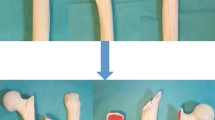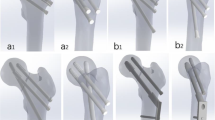Abstract
Background
Hip fractures account for a large proportion of hospitalization among the trauma cases. Low cost, simple technique, easy removal, and high rate of the bone union makes extramedullary (EM) fixation techniques a preferred choice. A close-fit bone and plate are essential for the success of such implantation. Various studies have found femur morphometry being related to regional features and social differences. Most of the available commercial implants are developed based on the data of the Caucasian population.
Methods
In the herein study, a novel design, Double Oblique Device for Osteosynthesis of hip (DODO), is proposed while considering the regional morphometry of the Northeast (NE) population of India. This study employs finite element (FE) analysis to compare the biomechanical outcome of the new device with that of proximal femoral locking plate (PFLP) and variable angle dynamic hip screw (VA-DHS) on a femur having an Evans type-I intertrochanteric fracture.
Results
The stress shielding was substantially high for the PFLP and VA-DHS in the distal bone fragment (lateral aspect) and for DODO in the femoral head. The difference in axial displacement between the post-implanted DODO-fixed femur and its respective intact femur was predicted to be almost the same as that of PFLP-fixed femur and its respective intact femur.
Conclusion
The computational results found the new device to be a viable alternative to the conventional plating techniques, especially for the NE population of India, and predicted better to comparable biomechanical characteristics.








Similar content being viewed by others
References
Rog, D., Grigsby, P., Hill, Z., Pinette, W., Inceoglu, S., & Zuckerman, L. (2017). A biomechanical comparison of the two- and four-hole side-plate dynamic hip screw in an osteoporotic composite femur model. Journal of Orthopaedic Surgery (Hong Kong), 25(2), 2309499017717199. https://doi.org/10.1177/2309499017717199
White, B. L., Fisher, W. D., & Lauren, C. A. (1987). Rate of mortality for elderly patients after fracture of the hip in the 1980’s. The Journal of Bone and Joint Surgery, 69A, 1335–1340
Sharma, A., Sethi, A., & Sharma, S. (2017). Treatment of stable intertrochanteric fractures of the femur with proximal femoral nail versus dynamic hip screw: A comparative study. Revista Brasileira de Ortopedia, 53(4), 477–481. https://doi.org/10.1016/j.rboe.2017.07.008
Yeganeh, A., Taghavi, R., & Moghtadaei, M. (2016). Comparing the Intramedullary nailing method versus dynamic hip screw in treatment of unstable intertrochanteric fractures. Medical Archives, 70(1), 53–56. https://doi.org/10.5455/medarh.2016.70.53-56 Epub 2016 Jan 31.
Bombaci, H., & Gorgec, M. (2003). Difficulty in removal of a femoral intramedullary nail: The geometry of the distal end of the nail. Yonsei Medical Journal, 44(6), 1083–1086. https://doi.org/10.3349/ymj.2003.44.6.1083
Aneja, A., Yang, E., Briscoe, M., Graves, M. L., Porter, S. E., Bergin, P., & Russell, G. V. (2014). Intramedullary nailing of femur fractures in the obese: A retrospective comparison of patients with normal weight versus the obese. Austin Journal of Trauma and Treatment , 1(1), 5
Brostrom, L. A., Barrios, C., Kronberg, M., Stark, A., & Walheim, G. (1992). Clinical features and walking ability in the early postoperative period after treatment of trochanteric hip fractures. Results with special reference to fracture type and surgical treatment. Annales Chirurgiae et Gynaecologiae, 81, 66–71
Haentjens, P., Casteleyn, P. P., & Opedecam, P. (1994). Hip arthroplasty for failed internal fixation of intertrochanteric and subtrochanteric fractures in the elderly patient. Archives of Orthopaedic and Trauma Surgery, 113(4), 222–227
Davis, T. R., Sher, J. L., Horsman, A., Simpson, M., & Porter, B. B. (1990). Checketts RG Intertrochanteric femoral fractures. Mechanical failure after internal fixation. The Journal of Bone and Joint Surgery British, 72, 26–31
Sathish Kumar, T., Senthilnathan, A., Prabhakar, R., & Harri, V. M. (2017). Implant of choice in the management of intertrochanteric fractures in south Indian rural population—a comparative study. National Journal of Clinical Orthopaedics, 1(3), 05–12
Ramachandra, S., Dayanand, M., Deepak, S., Narasimha, M., & Hanumantharaju, F. (2019). Outcome of proximal femoral locking compression plate (PFLP) in intertrochanteric femur fracture. International Journal of Orthopaedics Sciences, 5(3), 677–680. https://doi.org/10.22271/ortho.2019.v5.i3l.1612
Mahaisavariya, B., Sitthiseripratip, K., Tongdee, T., Bohez, E. L., Vander, S. J., & Oris, P. (2002). Morphological study of the proximal femur: A new method of geometrical assessment using 3-dimensional reverse engineering. Medical Engineering & Physics, 24(9), 617–622
Su, X. Y., Zhao, J. X., Zhao, Z., Zhang, L. C., Li, C., Li, J. T., et al. (2015). Three-dimensional analysis of the characteristics of the femoral canal isthmus: an anatomical study. BioMed Research International. https://doi.org/10.1155/2015/459612
Najjar, E. I., & McWilliams, E. R. (1978). Forensic anthropology: The structure, morphology and variations of human bone and dentition. Springfield: Charles C Thomas.
Ericksen, M. F. (1979). Ageing changes in the medullary cavity of the proximal femur in American black and whites. American Journal of Physical Anthropology, 51, 563–569
Saikia, K. C., Bhuyan, S. K., & Rongphar, R. (2008). Anthropometric study of the hip joint in northeastern region population with computed tomography scan. International Journal of Orthopaedics, 42(3), 260–266. https://doi.org/10.4103/0019-5413.39572
Agarwala, V., Paul, A., & Daolagupu, A. K. (2020). Anthropometric analysis of the hip joint in Southern Assam population using computed tomography. International Journal of Orthopaedics, 6(1), 1133–1139. https://doi.org/10.22271/ortho.2020.v6.i1o.1971
Siwach, R., & Dahiya, S. (2003). Anthropometric study of proximal femur geometry and its clinical application. Indian Journal of Orthopaedics, 37, 247
Rawal, B. R., Ribeiro, R., Malhotra, R., & Bhatnagar, N. (2012). Anthropometric measurements to design best-fit femoral stem for the Indian population. Indian Journal of Orthopaedics, 46(1), 46
Khang, G., Choi, K., Kim, C. S., Yang, J. S., & Bae, T. S. (2003). A study of Korean femoral geometry. Clinical Orthopaedics and Related Research (1976–2007), 406(1), 116–122
Pushparathna, S. B., Sangeetha, S., & Premavathy, D. (2019). Determination of height using femur length in adult population. Drug Invention Today, 12(4), 834–835
Ferguson, S. J., Wyss, U. P., & Pichora, D. R. (1996). Finite element stress analysis of a hybrid fracture fixation plate. Medical Engineering and Physics, 18(3), 241–250. https://doi.org/10.1016/1350-4533(95)00041-0
Tonino, A. J., Davidson, C. L., Klopper, P. J., & Linclau, L. A. (1976). Protection from stress in bone and its effects. Experiments with stainless steel and plastic plates in dogs. Journal of Bone and Joint Surgery Series B, 58, 107–113. https://doi.org/10.1302/0301-620x.58b1.1270486
Pathrot, D., Haq, R. U., Aggarwal, A. N., Nagar, M., & Bhatt, S. (2016). Assessment of the geometry of proximal femur for short cephalomedullary nail placement: An observational study in dry femora and living subjects. Indian Journal of Orthopaedics., 50(3), 269
McLoughlin, S. W., Wheeler, D. L., Rider, J., et al. (2000). Biomechanical evaluation of the dynamic hip screw with two- and four-hole side plates. Journal of Orthopaedic Trauma, 14, 318–323
Bolhofner, B. R., Russo, P. R., & Carmen, B. (1999). Results of intertrochanteric femur fractures treated with a 135-degree sliding screw with a two-hole side-plate. Journal of Orthopaedic Trauma, 13, 5–8
Wang, C. C., Lee, C. H., Chin, N. C., et al. (2020). Biomechanical analysis of the treatment of intertrochanteric hip fracture with different lengths of dynamic hip screw side plates. Technology and Health Care: Official Journal of the European Society for Engineering and Medicine., 28(6), 593–602. https://doi.org/10.3233/thc-202248
Mamidi, R. S., Kulkarni, B., & Singh, A. (2011). Secular trends in height in different states of India in relation to socioeconomic characteristics and dietary intakes. Food and Nutrition Bulletin., 32(1), 23–34. https://doi.org/10.1177/156482651103200103
Chansa, M. (2019). A cross—section study to determine human height using femur length in Zambian population. Acta Scientific Microbiology, 2(11), 57–61
Nag, P., & Chanda, S. (2021). Biomechanical design prognosis of two extramedullary fixation devices for subtrochanteric femur fracture: a finite element study. Medical & Biological Engineering & Computing, 59(2), 271–285. https://doi.org/10.1007/s11517-020-02306-6 Epub 2021 Jan 8 PMID: 33417126.
Abdulkareem, I. H. (2012). A review of tip apex distance in dynamic hip screw fixation of osteoporotic hip fractures. Nigerian Medical Journal, 53(4), 184–191. https://doi.org/10.4103/0300-1652.107550
Biomechanical products catalog Sawbones:Test materials and composite bones (2020). https://www.sawbones.com/media/assets/product/documents/biomechanical_catalog2020.pdf. Accessed 7 Dec 2020.
Freitas, A., Torres, G. M., Souza, A. C., Maciel, R. A., Souto, D. R., & Ferreira, G. N. (2014). Analysis on the mechanical resistance of fixation of femoral neck fractures in synthetic bone, using the dynamic hip system and an anti-rotation screw. Revista Brasileira de Ortopedia, 49(6), 586–592. https://doi.org/10.1016/j.rboe.2014.01.016
Kim, C., Chang, J. S., & Kim, J. W. (2019). Clinical outcomes of dynamic hip screw fixation of intertrochanteric fractures: Comparison with additional anti-rotation screw use. European Journal of Orthopaedic Surgery & Traumatology, 29, 1017–1023. https://doi.org/10.1007/s00590-019-02397-4
Sperner, G., Wanitschek, P., Benedetto, K. P., & Glotzer, W. (1989). Technical errors and early complications of osteosynthesis of pertrochanteric femoral fractures using the dynamic hip screw. Der Unfallchirurg, 92(12), 571–576
Zderic, I., Willhuber, G. C., Ahrend, M. D., et al. (2018). Biomechanical comparison between standard and inclined screw orientation in dynamic hip screw side-plate fixation: The lift-off phenomenon. Journal of Orthopaedic Translation, 18, 92–99. https://doi.org/10.1016/j.jot.2018.10.005
Rodriguez-Olaverri, J. C., Hasharoni, A., DeWal, H., Nuzzo, R. M., Kummer, F. J., & Errico, T. J. (2005). The effect of end screw orientation on the stability of anterior instrumentation in cyclic lateral bending. The Spine Journal, 5(5), 554–557
Perren, S. M., Linke, B., Schwieger, K., Wahl, D., & Schneider, E. (2005). Aspects of internal fixation of fractures in porotic bone. Principles, technologies and procedures using locked plate screws. Acta Chirurgiae Orthopaedicae et Traumatologiae Cechoslovaca, 72(2), 89–97
Stoffel, K., Stachowiak, G., Forster, T., Gachter, A., & Kuster, M. (2004). Oblique screws at the plate ends increase the fixation strength in synthetic bone test medium. Journal of Orthopaedic Trauma, 18(9), 611–616
Ratner, D., Hoffman, S., Schoen, J., & Lemons, E. (2004). Biomaterials science—an introduction to materials in medicine. New York: Elsevier.
Prukvilailert, M., & Koguchi, H. (2005). Stress singularity analysis around the singular point on the stress singularity line in three-dimensional joints. International Journal of Solids and Structures, 42, 3059–3074
Acknowledgements
The authors would like to acknowledge the computational facilities available at the Biomechanics Laboratory, Department of Biosciences and Bioengineering, Indian Institute of Technology Guwahati, India, which has helped carry out this research study. The study has been partially supported by SERB, India (Grant no. SRG/2019/000235). The authors are also thankful to Sharma Pharmaceutical Pvt Ltd., Gujrat, India, for their generous support by freely providing the PFLP implants for this study.
Author information
Authors and Affiliations
Corresponding author
Ethics declarations
Conflict of interest
The authors hereby declare that there are no potential conflicts of interest regarding any financial support, research, authorship and publication of this article.
Ethical standard statement
This study was approved by the National Healthcare Group Institutional Review Board.
Informed consent
Informed consent was obtained from all individual participants included in the study.
Rights and permissions
About this article
Cite this article
Nag, P., Borgohain, B. & Chanda, S. Novel Design of Minimal Incision Double Oblique Device for Osteosynthesis (DODO) of Hip: Results of an In-silico Study Based on the Femur Morphometrics of the Northeast (NE) Indian population. JOIO 55 (Suppl 2), 385–394 (2021). https://doi.org/10.1007/s43465-021-00408-3
Received:
Accepted:
Published:
Issue Date:
DOI: https://doi.org/10.1007/s43465-021-00408-3




